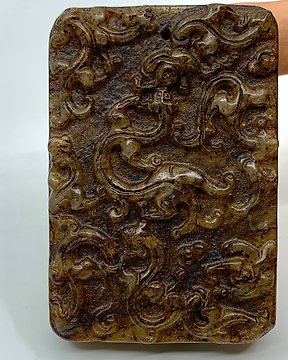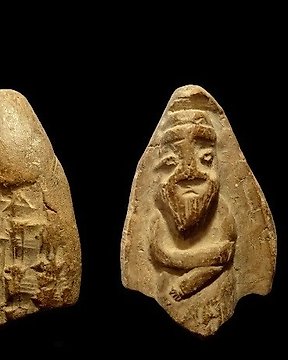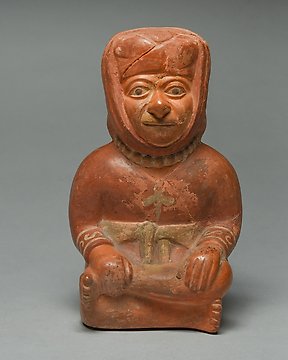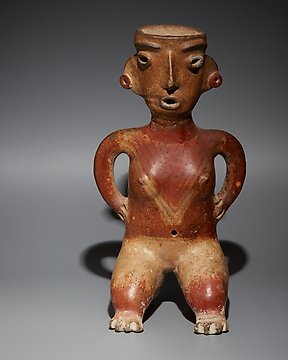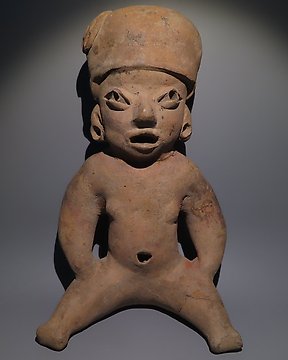Ősi kínai Kerémia Szecsuán. Udvari ágyasnő. 57,5 cm H. Han-dinasztia, Kr.e. 206 körül – i.sz. 220.
Nr. 84871211
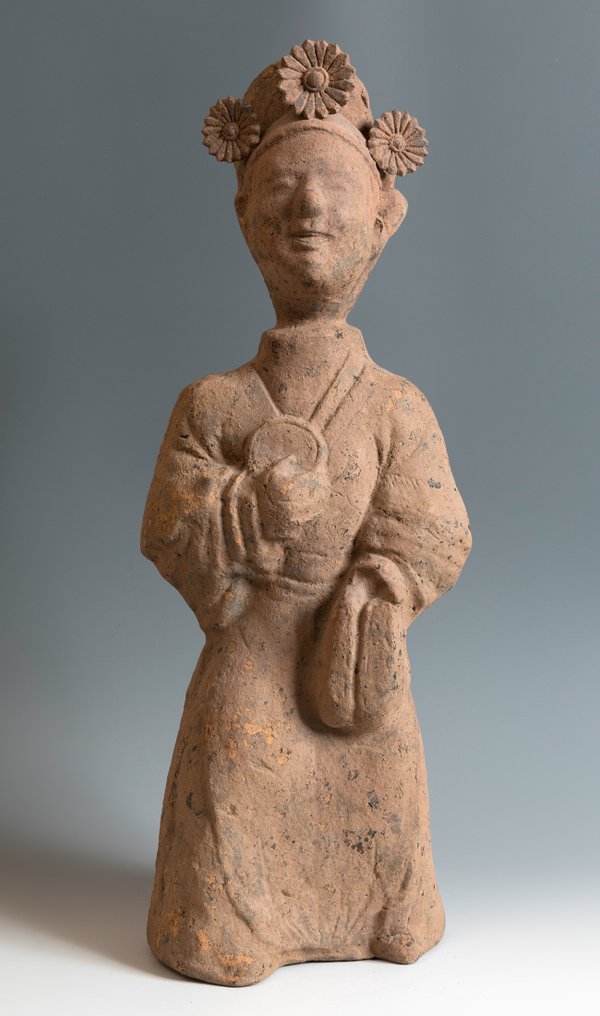

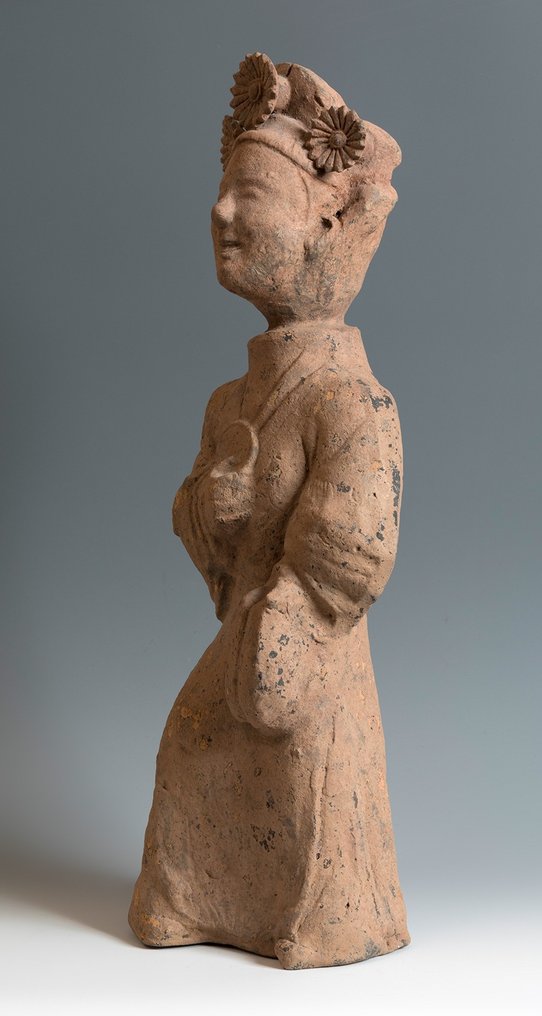
Sichuan. Court concubine.
57.5 cm H.
Ancient Chinese
Han Dynasty, Circa 206 BC - 220 AD
Pottery
PROVENANCE: Private collection, Paris, France, 1970.
CONDITION: Intact.
The art of the Han dynasty (206 BCE - 220 CE) of ancient China is characterised by a new desire to represent everyday life and the stories from history and mythology familiar to all. The arts were fuelled both by a political stability with its consequent economic prosperity and the development and highly successful combination of brushes, ink, and paper. Calligraphy, painting, lacquerware production, and jade carving were just some of the areas Han artists pushed forward the boundaries of what was possible to make technically and what was desired aesthetically by the ever-increasing number of art connoisseurs.
Large figure sculptures are rare from the Han period, but there are some statues representing generals and officials which were stood outside their tombs. Smaller-scale works include cast bronze sculptures of horses which are common in 2nd-century CE Han tombs. These are usually depicted in full gallop with only one hoof resting on the base so that they almost appear to be flying.
Painted earthenware figurines of single standing women, men, and servants are common. Cast bronze was used to make small figurines and ornate incense burners. These were often inlaid with gold and silver or gilded. One superb piece is a gilded bronze oil-lamp in the form of a kneeling servant girl, which dates to the late 2nd century BCE.
Jade was especially esteemed for its rarity, durability, purity, and certain mystical qualities. The material was carved into all manner of animals, people, and mythical creatures. Han Jade carvers now used circular cutting drills and iron tools, but pieces often have a lower quality finish than previously, which suggests they were starting to be made quicker and on a larger scale of production. Another feature of Han jade sculpture is the use of flaws and impurities in the jade to make them part of the sculpture. From the 1st century BCE, a pure white jade became available from central Asia following the expansion of the Han empire.
One unique but stunning art form was the creation of jade 'suits' to cover the body of the deceased in royal tombs. The 'suits' cover the contours of the body and are made from up to two thousand individually carved rectangular pieces of jade stitched together using gold or silver wire. Two outstanding examples come from the late 2nd century BCE tomb of Prince Liu Sheng and Princess Dou Wan at Mancheng. Reserved only for royalty, they nevertheless became so costly to produce that later rulers banned their use.
Notes:
The seller guarantees that he acquired this piece according to all national and international laws related to the ownership of cultural property. Provenance statement seen by Catawiki.
The piece includes authenticity certificate.
The piece includes Spanish Export License.
#theaterasia
Az eladó története
Sichuan. Court concubine.
57.5 cm H.
Ancient Chinese
Han Dynasty, Circa 206 BC - 220 AD
Pottery
PROVENANCE: Private collection, Paris, France, 1970.
CONDITION: Intact.
The art of the Han dynasty (206 BCE - 220 CE) of ancient China is characterised by a new desire to represent everyday life and the stories from history and mythology familiar to all. The arts were fuelled both by a political stability with its consequent economic prosperity and the development and highly successful combination of brushes, ink, and paper. Calligraphy, painting, lacquerware production, and jade carving were just some of the areas Han artists pushed forward the boundaries of what was possible to make technically and what was desired aesthetically by the ever-increasing number of art connoisseurs.
Large figure sculptures are rare from the Han period, but there are some statues representing generals and officials which were stood outside their tombs. Smaller-scale works include cast bronze sculptures of horses which are common in 2nd-century CE Han tombs. These are usually depicted in full gallop with only one hoof resting on the base so that they almost appear to be flying.
Painted earthenware figurines of single standing women, men, and servants are common. Cast bronze was used to make small figurines and ornate incense burners. These were often inlaid with gold and silver or gilded. One superb piece is a gilded bronze oil-lamp in the form of a kneeling servant girl, which dates to the late 2nd century BCE.
Jade was especially esteemed for its rarity, durability, purity, and certain mystical qualities. The material was carved into all manner of animals, people, and mythical creatures. Han Jade carvers now used circular cutting drills and iron tools, but pieces often have a lower quality finish than previously, which suggests they were starting to be made quicker and on a larger scale of production. Another feature of Han jade sculpture is the use of flaws and impurities in the jade to make them part of the sculpture. From the 1st century BCE, a pure white jade became available from central Asia following the expansion of the Han empire.
One unique but stunning art form was the creation of jade 'suits' to cover the body of the deceased in royal tombs. The 'suits' cover the contours of the body and are made from up to two thousand individually carved rectangular pieces of jade stitched together using gold or silver wire. Two outstanding examples come from the late 2nd century BCE tomb of Prince Liu Sheng and Princess Dou Wan at Mancheng. Reserved only for royalty, they nevertheless became so costly to produce that later rulers banned their use.
Notes:
The seller guarantees that he acquired this piece according to all national and international laws related to the ownership of cultural property. Provenance statement seen by Catawiki.
The piece includes authenticity certificate.
The piece includes Spanish Export License.
#theaterasia
Az eladó története
- 755
- 7
- 0
goede foto's, goede omschrijving, goed verpakt en snel verzonden.
Fordítás megtekintésemolto bello tutto ok
Fordítás megtekintésePezzo come da descrizione, davvero notevole. Venditore molto consigliato in quanto gentile e disponibile. spedizione molto veloce. Ottimo!
Fordítás megtekintéseVenditore davvero ottimo e gentile. Merce come da descrizione, spedizione veloce. Ottimo l'avere certificato di autenticità.
Fordítás megtekintéseUn 100 como empresa un 100 como envío . Empresa muy especial con mucha exquisitez en todos los productos y en personal . Muchas gracias
Fordítás megtekintéseAll well! Thanks.
Fordítás megtekintéseVery nice and fine cut little jewel! Well packed too! Thanks!
Fordítás megtekintésenice piece and very fast shipping!
Fordítás megtekintéseEs una maravilla de moneda, donde se le nota los pasos de los años y me encanta. Servido muy rápido y bien empaquetado. Con su certificación. Qué más se puede pedir?
Fordítás megtekintéseSnelle en correcte levering, alleen was de verpakking voor het schilderij niet stevig genoeg.
Fordítás megtekintéseHerzlichen Dank!
Fordítás megtekintéseAll OK and with very fast shipping.
Fordítás megtekintésePrachtig schilderij. Zo blij mee. Zeer nette verkoper en zeer snelle levering.
Fordítás megtekintéseperfect ! very fast and high quality delivery !
Fordítás megtekintéseAll well! Thanks.
Fordítás megtekintéseVendeur très professionnel, top +++×
Fordítás megtekintésePhotos trop contrastées pour bien percevoir les défauts, mais ces défauts étaient visibles pour autant. Le "Bon état" est trompeur. Sinon, envoi rapide et correctement emballé. Frais de port exagérés.
Fordítás megtekintéseGreat communication, delivery and product. Came with a well made certificate of authenticity and good packaging. Overall very happy with the purchase! Delivery is a bit expensive, but I recommend it
Fordítás megtekintéseMagnifique témoin du passé, envoyé avec tous les justificatifs, impeccable. Encore une fois très satisfait, un grand merci
Fordítás megtekintéseThank you for the Special offer and the fast shipping of this excellent piece of art!
Fordítás megtekintésevery good description of the object, very good price for this rare item,. Fast sending (has been at my place 2 days after buying!). Definitely would buy again.
Fordítás megtekintéseSehr schön
Fordítás megtekintéseAs described, perfect logistic
Fordítás megtekintésegreat seller, everything came as should with certificate of authenticity
Fordítás megtekintése- 755
- 7
- 0
Lemondás
Az eladó garantálja, hogy a tárgy a jogszabályoknak megfelelően került hozzá, és ezt bizonyítani is tudja. Az eladó kapott információt a Catawikitől arról, hogy a tárgyhoz mellékelnie kell a tartózkodási helyének megfelelő jogszabályok alapján szükséges dokumentációt. Az eladó garantálja a tárgy eladását/exportját és jogában áll mindez. Az eladó minden a tárggyal kapcsolatban szükséges információt továbbít a vevőnek. Az eladó biztosítja, hogy minden szükséges engedély el lett/lesz intézve. Az eladó azonnal tájékoztatja a vevőt, amennyiben az engedélyek beszerzése késik.
Az eladó garantálja, hogy a tárgy a jogszabályoknak megfelelően került hozzá, és ezt bizonyítani is tudja. Az eladó kapott információt a Catawikitől arról, hogy a tárgyhoz mellékelnie kell a tartózkodási helyének megfelelő jogszabályok alapján szükséges dokumentációt. Az eladó garantálja a tárgy eladását/exportját és jogában áll mindez. Az eladó minden a tárggyal kapcsolatban szükséges információt továbbít a vevőnek. Az eladó biztosítja, hogy minden szükséges engedély el lett/lesz intézve. Az eladó azonnal tájékoztatja a vevőt, amennyiben az engedélyek beszerzése késik.

